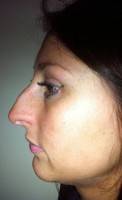Can Rhinoplasty Be Done Without Breaking The Nose?
Nose “breaking” during Rhinoplasty?
When someone speaks of “breaking” a nose, they are usually referring to the boney portion of the nose. In fact, only the upper one third to one half of the nose involves the nasal bones. If any reduction or straightening of the nasal dorsum (the top of the nose) is required, bone work will likely be involved.
However, very precise instruments are used so that the nasal bones are cut, rather than “broken”. So, breaking the nose during surgery for nose bone is not urban legend.
Understanding the degree of precision that is used in doing this will hopefully eliminate any fear around this concept, as it applies to Rhinoplasty. (Michael R. Macdonald, MD, Bay Area Facial Plastic Surgeon)
Both doctors and patients often use the term “breaking the nose” to describe one of the steps of a rhinoplasty.
What actually happens is that a special instrument called an osteotome is used to make a cut through the bone in such a way that the nasal bones can be pushed closer together after the removal of the “hump.”
It is a more controlled maneuver than what is implied in the term “breaking” the nose. (Paul W. Loewenstein, MD, Milwaukee Plastic Surgeon)
A controlled osteotomy is often performed during rhinoplasty
A controlled osteotomy or ‘breaking of the nose’ is often performed during rhinoplasty in order to achieve the proper aesthetic result.
You should not worry about this as this is a common procedure used and in itself is not a painful aspect of the procedure. You should allow your surgeon to use the techniques that are necessary to help him or her achieve the best aesthetic result possible. (Sanjay Grover, MD, Orange County Plastic Surgeon)
Breaking nose during rhinoplasty
Don’t be afraid! Your nose is not broken or snapped in the usual sense during a rhinoplasty. If the bones need re-positioning, then careful cuts will be made to allow them to move. You will be under anesthesia and not feel anything or be aware of what is done. Afterwords, there usually is very little discomfort. Be sure to discuss any fears you have with your surgeon. (Randy J. Buckspan, MD, Austin Plastic Surgeon)
Need for osteotomies (seperating nasal bones) during Rhinoplasty
This is a common concern of many undergoing surgery for nose bone. As many have stated, your surgeon does not “break” the nasal bones. Your surgeon may carefully seperate your nasal bones with a special instrument called an osteotome. This manuver is called “osteotomies”. Not all patients need osteotomies. If, however, you have a large nasal hump or a wide nasal bridge your surgeon will likely need to perform this manuver. Explain any concerns you have to your surgeon in the consultation phase. Remember to make sure your surgeon is Board Certified by The American Board of Facial Plastic and Reconstructive Surgery, The American Board of Cosmetic Surgery or The American Board of Plastic Surgery. (Gregory Pippin, MD, Metairie Facial Plastic Surgeon)
Your bones are often ‘broken’ during rhinoplasty. However many times this isn’t necessary. And when it is needed, the nasal bones are broken in the sense they are randomly fractured. Your surgeon carefully makes cuts in the bones so they can be moved slowly and accurately to a better position. (Oakley Smith, MD, Toronto Facial Plastic Surgeon)
Rhinoplasty Cuts, not “Breaks” Bones
There is a common misconception that a surgeon “breaks” your bones during a rhinoplasty. To make an analogy, think of a carpenter, the carpenter would never be spoken of as “breaking” wood (at least not a good one!).
If the bony parts of your nose need to have the shape changed, there is really no other option but to cut and move the bones. It is done with special instruments designed to make precise clean cuts.
As I do it, you are soundly sleeping under deep sedation and blissfully unaware of the surgery for nose bone. It does not hurt afterward and in a few weeks the bones heal up in the new location. (Louis W. Apostolakis, MD, Austin Facial Plastic Surgeon)
Breaking the Nose During Rhinoplasty
Breaking the nose during rhinoplasty is not what you imagine. It is a controlled weakening of bones of the nose.
This may be necessary to narrow the width of the nose to produce a pleasing result. (Earl Stephenson, Jr., MD, DDS, Atlanta Plastic Surgeon)
Is breaking the nose necessary for every rhinoplasty?
“Breaking the nose” is the lay term for “osteotomies” – delicately cutting/freeing the nasal bones to achieve appropriate proportions between the upper and lower part of the nose.
Osteotomies can also close an “open roof” from removing a large hump or straighten a crooked or previously broken nose. While not necessary in every rhinoplasty, most noses benefit from these osteotomies.
While I will tell certain patients they may not need osteotomies – and I will try to avoid them in those patients – I would never promise not to ever do an osteotomy in any given case, as it may compromise the ultimate result.
While “breaking the nose” implies trauma of an uncontrolled and violent nature, osteotomies are actually very precise and delicate.
Contrary to popular belief, rhinoplasty with osteotomies is actually no more painful than without. (Laxmeesh Mike Nayak, MD, Saint Louis Facial Plastic Surgeon)
3 Reasons a doctor may have to break your nose during rhinoplasty.
The idea of a nose break is pretty scary to most people. The truth is it’s even a little daunting to young surgeon’s first learning to do rhinoplasty. During the nasal bone surgery, the nose break (osteotomy) is a time where the anesthesiologists, and sometimes the nurses look away.
The good news is, making breaks in the nasal bones does not hurt during the procedure because the patient is under general anesthesia. Making the breaks in the bone, like all the steps during rhinoplasty, would be painful if not for the wonderful thing called anesthesia. The bones may need to be broken for the following reasons:
- To straighten some crooked or deviated noses.
- To narrow noses that are wide at the dorsum (bridge).
- To narrow some noses after removing a large nasal hump.
So while the idea of having the nose broken can be scary, it can be really helpful in modifying the nose and does not add a lot of discomfort to the procedure. In fact, none of the patients I have treated have ever complained about intense pain from osteotomies during nasal bone surgery. For more info on Rhinoplasty, please click the link below. (David Mabrie, MD, Bay Area Facial Plastic Surgeon)
Surgeons “break” your nose. But using the word “break” implies out of control trauma to the area. We as plastic surgeons and especially those of us who do nasal bone surgery make sure the bones are “fractured” using controlled “osteotomies”. These osteotomies come in many varieties according to what needs to be done to your nose to decrease its width. Control and precision is key in rhinoplasty to ensure consistently predictable results. (John Philip Connors III, MD, FACS, Atlanta Plastic Surgeon)
Nasal fracture as part of rhinoplasty
We may try and use euphemisms in describing a rhinoplsty but the reality is, yes, we do fracture the nose in the majority of aesthetic nasal bone surgery. The bones on the side of the nose are fractured with a chisel to move them toward the middle and create a more narrow and refined look. This is typically done in conjunction with refinement of tip structures and removing any hump that is prominent. (Talmage J. Raine, MD, Champaign Plastic Surgeon)
Rhinoplasty and nasal bones
It is rather common in my practice for patients to ask questions about “breaking the bones” of the nose. In reality the nasal bones are not broken during nasal bone surgery. In some patients I perform re-contouring of nasal bridge to achieve better balance, or to straighten the nose.
In those cases I manipulate the nasal bones with special instruments. Even thought this maneuver can cause some bruising in reality in is virtually painless.
For most patients it is part and parcel of the rhinoplasty procedure. (Boris M. Ackerman, MD, Newport Beach Plastic Surgeon)
Osteotomy – if it’s needed, you want it
Nasal bones are “broken” in a delicate and precise fashion. We call this an osteotomy or cutting of the bone. It is needed if:
- a hump is removed
- The nose is crooked and needs to be straightened or
- If the nasal bones are wide and the patient desires for them to be narrowed, Although this sounds scary – if your surgeon is experienced in rhinoplasty there is nothing to worry about! (Benjamin C. Marcus, MD, Madison Facial Plastic Surgeon)
Bones are reshaped during rhinoplasty
Most patients are worried about their nasal bones being “broken” during a rhinoplasty. Usually, if the goal is to straighten a crooked nose or narrow the upper 1/3 of the nose, then yes, the nasal bones have to be repositioned. This involves precise cuts in the bone and then they’re reshaped accordingly. I tell patients not to worry about technical details of this or any other surgery and instead focus on their aesthetic and medical goals. (Ramtin Kassir, MD, Wayne Facial Plastic Surgeon)
Management of Nasal Bones During Rhinoplasty
The nasal bones are often repositioned during rhinoplasty to close the “open roof” after lowering a “dorsal hump” and to narrow the nose slightly.
Repositioning bones involves very controlled fractures, but this is a necessity if you want a narrower nose.
If under general anesthesia, you don’t see it, hear it, feel it, and afterward, you’ll never realize it has been done. (Steve Laverson, MD, Seattle Facial Plastic Surgeon)
Breaking of the bone with rhinoplasty
An osteotomy is sometimes performed during rhinoplasty to narrow the bridge of the nose.
It does not have to be performed during every surgery, however, it is almost vital in some cases. Discuss this with your surgeon, as it is an important element in some rhinoplasties. (Raffy Karamanoukian, MD, FACS, Baltimore Facial Plastic Surgeon)
Possible need to break nasal bones during rhinoplasty
Depending on what maneuvers are performed to reshape your nose controlled bone fractures (osteotomies) may be needed during your surgery.
Common indications are: The nasal bones (the upper 1/3 of your nose) are deviated or excessively wide. You have a hump on your bridge that you want removed.
Your surgery will need to shift the nasal bones inward after this to avoid leaving you with what’s called an open roof deformity (i.e., an excessively flat, wide bridge)
As mentioned, osteotomies are done in a very controlled manner using fine chisels which create small fracture lines in the nasal bones. In my experience, patients don’t have any more pain than patients not needing osteotomies. (Thomas A. Lamperti, MD, Los Angeles Plastic Surgeon)
Handling the nasal bones in rhinoplasty
The vast majority of patients who undergo rhinoplasty to change the way their nose looks are ultimately extremely pleased with their result, regardless of whether the nasal bones are “broken” or not.
This question is an extremely common one asked by patients considering rhinoplasty for a number of reasons. Patients fear it will be very painful and cause them to have black eyes. Many of them have watched rhinoplasty videos on YouTube and found the process of breaking the bones disturbing.
The nasal bones are surgically broken with special instruments designed specifically for that purpose in some rhinoplasty cases but not all. They are typically broken when a “hump” on the nose is being removed, or when a nose that is wide at the top needs to be narrowed.
They also are frequently broken when a nose that is “crooked” needs to be straightened. Regardless of the indication, the maneuver is performed in a very precise, elegant, deliberate fashion. While it does usually lead to black eyes postoperatively, these subside during the one week recovery period, and pain is well-controlled with oral pain medication.
In conclusion, this technique plays an important role in specific cases, and should not be a source of extreme anxiety for the patient contemplating rhinoplasty. (Lisa Ishii, MD, Boca Raton Facial Plastic Surgeon)
Rhinoplasty Terminology- “Breaking the nose”
Many patients are haunted by the phrase, “breaking the nose.” I get asked this questions very often during my rhinoplasty consult. When referring to this, most people are referring to a procedure called an osteotomy. An osteotomy is performed only in SOME rhinoplasties in order to narrow the bridge of the nose. This is a controlled fracture of the nasal bones, which are very thin and comprise the upper one-third of the nose. The term “breaking the nose” is a much more gruesome term that implies that this is not a controlled step. Osteotomies are carefully planned and executed by the surgeon and are a very “surgical” procedure.
This being said. I certainly do NOT perform osteotomies on every rhinoplasty as they are often not necessary. This will depend on the goals of surgery. (Jacob D. Steiger, MD, )
There are many reasons why your nasal bones may be broken if you have a rhinoplasty. Here are the most common reasons: if a large hump is removed from the bridge, you may end up having the edges of the nasal bones no longer touching at the midline, resulting in a wide, flat bridge (this is called an ‘open roof”);
breaking and repositioning the bones will correct this problem your nasal bones are wide, and bringing them closer together will make your nose more attractive your bones are crooked or asymmetric, and need to be straightened
Breaking the nose is done in a precise manner with surgical instruments. Small perforations in the bone are made to weaken the bone along the line of the intended break. Once this is accomplished, the bone will ‘break’ with a small amount of finger pressure. The bone does not break completely loose, and there are small attachments which keeps the bone stable in the desired position. (Lawrence Tong, MD, Toronto Plastic Surgeon)


